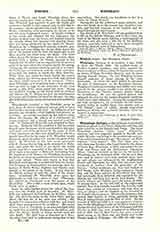

Winnebago Indians, a tribe of Siouan stock closely related in speech to the Iowa, Missouri, and Oto, and more remotely to the Dakota and Ponca. The name Winnebago signifies “filthy water” (Chippewa, winipeg), and was originally applied to the lake near which the tribe was living in the seventeenth century. They called themselves Horogi, “fish-eaters”, or Hochungarra, “trout nation”. The first white man to visit them was Nicollet, who found them by the shores of Green Bay, Wisconsin, in 1634, surrounded by the Sauk and Foxes and the Menominee, Algonquin tribes. They are referred to, but not by the name of Winnebago! by the Jesuits in 1636. On the west they were then in contact with their kindred Iowa; their art and culture was influenced by the neighboring Siouan and Algonquin, but they were not much more advanced in warfare than the generality of the Dakota. Tribal traditions say they had resided at Red Banks, Lake Michigan, before coming to Green Bay, and the Jesuit relation of 1671 states that they had previously been defeated and captured by the Illinois, but had been later given their liberty. The Jesuits Allouez and Dablon spent the winter of 1669-70 among them. In the first half of the eighteenth century they were friendly towards the French, with whom they carried on commerce, and were slow to form an alliance with the English on the downfall of the French colonial power. Eventually, however, they proved their loyalty to them, especially during the War of Independence and the War of 1812. By the treaties of 1825 and 1832 they were granted a reservation on the Mississippi north of the River Iowa in exchange for their lands south of the Wisconsin and Fox Rivers; in 1846 they were transferred to Minnesota and in 1856 were at Blue Earth, but were removed again owing to the Sioux war, and finally sent to the Omaha lands in Nebraska. In 1886 the tribe numbered 2152, and in 1910 had increased to 2333, of whom 1063 were in Nebraska and 1270 in Wisconsin, whither many returned from the reservation. The Winnebago lived in wigwams with rush-mat coverings; they were not advanced in agriculture, but lived chiefly on fish, wild rice, and game, and obtained sugar from the maple tree.
The religious belief of the Winnebago resembled those of the Dakota and central Algonquins, their chief deity being the Manuna or earth-maker. Their mythology is chiefly Siouan, and relates in particular to five individuals created by Manuna to free the world from evil spirits and giants. The Winnebago had a tradition of the Deluge; their paradise was in the skies, and the Milky Way they believed to be the path by which those who died journeyed to heaven. The tribe have two great ceremonies. The Mankani or medicine dance, which takes place in summer and is performed by the members of the secret society, has for its object the prolongation of life and the inspiration of virtues. The latter is accomplished by the “shooting” ceremony, that is the pretended shooting of a shell in an otter-skin bag into the body of the candidate for initiation. The other feast, Wagigo, takes place in winter, and is intended to increase the martial spirit of the tribe by propitiating all their deities with offerings of food and deerskins. Little is known of various other minor dances, such as the Snake, Ghost, and Grizzly-Bear. The Winnebago had twelve clans, four in the Air division, eight in the Earth division. Generally an Air individual had to marry an Earth, and vice versa. The lodge of the Thunderbird, an Air clan, possessed the right of sanctuary; while that of the Bear, an Earth clan, was the war and punishment lodge.
A. A. MACERLEAN

